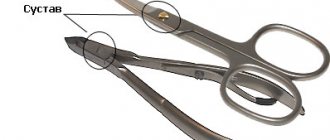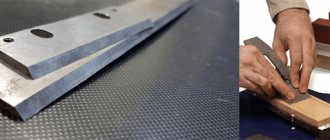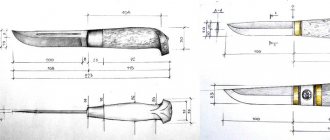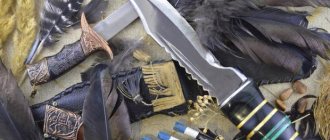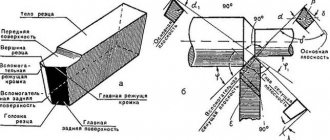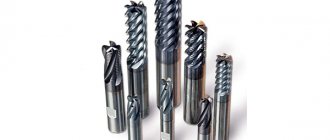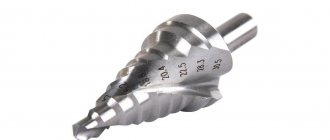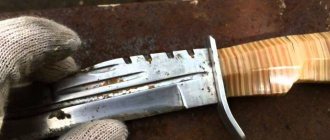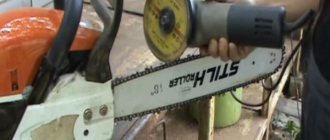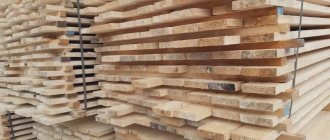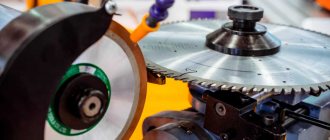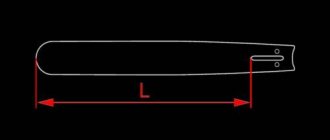Classic profile
The radius longitudinal profile is measured by the radius in feet. For example: 14″ designation means the radius of the profile template is 14 feet. Used for profiling the blades of hockey skates: children's, beginner hockey players and amateurs. Sharpening is done on machines according to factory patterns with a sharpening radius from 7″ to 30″.
The most popular single profile patterns for children's skates:
- 11″ - for small players with good skating skills;
- 15″ - for young beginners;
- 17″ - for beginner young players with a lot of weight.
How to choose hockey equipment for a child, read our articles
Skates Stick Helmet Hockey bag Puck
Combined profiling method
The blade of a hockey skate can be divided into three working zones: toe, middle, heel. Each zone is responsible for performing its own maneuver (turn, turn, slide).
The essence of the method. Each part of the blade has its own spot of contact with the ice. After profiling, a blade with a complex configuration is obtained. Sharpening is carried out only on specialized machines using templates. This method is popular among professional players.
Detroit Templates
A dual sharpening style for ice hockey skates like the Detroit 1 (10-20ft) provides the player with the most stability on the ice. At the same time, speed and maneuverability are slightly reduced.
For goalies, players who skate a lot with their backs forward, and heavy defensive players, the Detroit 2 (13-26 feet) is suitable.
Zuperior Templates
The triple type of sharpening is used to increase balance, speed, and maneuverability.
There are several Zuperior templates:
- S (6-12-26 ft) - skate blade size 24.6 cm; 25.4 cm; 26.3 cm;
- M (6-13-26 ft) - 27.2 cm; 28 cm; 28.8 cm;
- L (6-14-26 ft) -29.6 cm; 30.6 cm; 31.2 cm.
- V (6-17-26 feet) -29.6 cm; 30.6 cm; 31.2 cm - used for goalkeepers and heavy players.
All templates give athletes additional stability during the game, which does not affect speed.
Flat Bottom V (FBV)
The latest trapezoidal sharpening type developed over 20 years ago in North America. It is considered the most effective in terms of efficiency of all listed types. Actively used by hockey players in the NHL.
It is turned only on professional BLACKSTONE and BLADEMASTER machines, which creates difficulties for hockey players in Russia. The companies are not represented on the Russian market; you will have to pay dearly for replacing elements or new sharpening.
The essence of FBV sharpening lies in the peculiar shape of the groove. The channel in the inner plane of the blade is sharpened along a trapezoid. Due to this, a more rigid grip on ice is created, but ease of sliding is maintained. Sharp edges give the skates stability for maneuvers.
It is worth noting that in addition to the price, there is an equally significant disadvantage - the blade grinds off faster with this type of sharpening. Despite this, FBV has recently been gaining popularity in Russia among hockey players.
Types of sharpening hockey skates
The convenience of play and the safety of the athlete depends on the correct sharpening of hockey skates. There are several standards that apply during the procedure.
The basic term is groove (gutter). You can often see names such as radius, notch, groove.
The sharpening radius (groove depth) is affected by:
- athlete's weight;
- hockey player's skating style;
- hockey player skill level.
The numbers in the table indicate the depth of the groove. In this case, the lower the value, the deeper the recess will be and the sharper the edges. More value means less depth of the groove, less sharpness of the edge.
Table of standard groove values for sharpening hockey skates of a forward
| Athlete's weight, kg | ||||||
| Athlete's level of training | 20-30 kg | 30-50 kg | 50-70 kg | 70-90 kg | 90-110 kg | 110 and above kg |
| Professional | 12-14 m1 | 13-16 mm | 14-17 mm | 15-20 mm | 17-25 mm | 20-30 mm |
| Amateur | 10-13 mm | 12-14 mm | 13-15 mm | 17-30 mm | 15-18 mm | 16-20 mm |
| Beginning | 9-12 mm | 10-12 mm | 11-12 mm | 12-13 mm | 13-15 mm | 14-16 mm |
Table of standard groove values for sharpening defender's hockey skates
| Athlete's weight, kg | ||||||
| Athlete's level of training | 20-30 kg | 30-50 kg | 50-70 kg | 70-90 kg | 90-110 kg | 110 and above kg |
| Professional | 11-13 mm | 12-14 mm | 13-15 mm | 14-17 mm | 15-20 mm | 18-25 mm |
| Amateur | 10-12 mm | 11-13 mm | 12-14 mm | 15-20 mm | 14-16 mm | 15-18 mm |
| Beginning | 9-12 mm | 10-12 mm | 11-12 mm | 12-13 mm | 13-15 mm | 14-16 mm |
You need to focus not only on the table, but also on the player’s personal preferences.
- For stable skating and with turns, you should choose a sharpening with a deep groove - from 9 to 14 mm.
- To increase the rolling speed, you will need to increase the groove size to 20 mm or more.
Main types of sharpening:
- Radius (standard sharpening).
- Channel-Z
- Flat Bottom V.
How can you sharpen your skates yourself?
Many people think that there is no need to sharpen new skates since they are already from the factory. This is not true, factory sharpening is suitable only for a few. Therefore, you will have to try. The most interesting thing is that athletes trust only a few with this work. These are sharpening professionals. After all, a small error can cause a fall when performing complex tricks.
Ways to sharpen skates:
- File
- Nadfilkom
- Bulgarian
How can you sharpen your skates yourself?
Sharpening Channel-Z
A special feature of this type of sharpening is the presence of an additional notch in the middle of the standard groove. It is made in the form of a square.
Channel-Z has its own sequence of sizes. The depth can be 0.8-1.6 mm. The channel width is divided into 3 types - S, M, L.
Among the advantages noted:
- Increased maneuverability and riding speed.
- Reducing resistance.
- An additional recess collects ice crumbs that melt during the game. Melted water is an additional lubricant that ensures better gliding of the skate.
Among the minuses noted:
- High cost of the service.
- The process takes longer.
- Sharpening requires professional equipment (Sweden).
- Sharpening can only be done by a highly qualified specialist.
Sharpening "FBV"
For more than 25 years, a Canadian development, FBV, has been used to sharpen skates. In this case, the groove takes the shape of a trapezoid, which allows you to achieve a good efficiency when skating.
Flat Bottom “V” has a number of advantages:
- Rigid adhesion of the blade to the ice.
- Increased stability.
Among the disadvantages, athletes note the fragility of sharpening. Since the thin trapezoidal walls cannot withstand the load, roughness and chips appear.
Benefits of sharpened skates
Properly prepared skates have a number of advantages:
Provides improved balance and better ride control. The legs do not slip, it is easier to balance and maintain balance when turning;
Reduced friction, improved sliding quality. The friction force is less, therefore less effort is spent on skating;
Maneuverability and acceleration. You can play more aggressively, good grip on the surface provides acceptable maneuverability, you can push off harder without the risk of slipping, and accordingly the acceleration becomes sharper.
How to tell if your skates are dull
Sharpening of hockey skates is required immediately after purchase and during use. There are several signs that ammunition has become dull:
- When starting to move, the skate slips.
- There is a feeling of stalling when turning.
- When you run the tip of your nail along the blade, there is no mark left on the nail plate.
Look at the outline from the front. Both edges must be of equal height and a groove must be visible. When turning at right angles, the blade profile has the shape of the letter P. If other parameters are observed during inspection, sharpening is necessary.
Let's secure the information
Choose a sharpening for yourself, taking into account the characteristics of each technique. Modern requirements for sharpening skates tend to move towards European regulations. The main task is to reduce friction and effectively ride without losing speed.
Remember the basic rules for blade care to keep your edge sharp longer. Do not wear skates on hard surfaces without protective covers. Clean your blades after skating on ice. Contact a sharpening specialist regularly; do not allow the blade to wear out completely. Over time, blades lose gliding speed, resulting in poor preparation or performance on the ice.
Sharpening hockey skates at home
Blade sharpness is important for hockey skates. Because the speed and maneuverability of the player depends on the correct sharpening. When sharpening ammunition at home, you need to follow a number of rules that will help you avoid common mistakes.
Main mistakes and their consequences
| Error | Consequences of an error |
| The inner and outer sides of the blades are not symmetrical. | Leads to loss of balance. |
| A lot of steel has been removed from the toe and heel. | The skate is unbalanced and the balance is lost. |
| Blade overheating. | The durability of the metal decreases. |
| Blade profile and groove radius are damaged | Negatively affects the quality of skating. |
How to sharpen hockey skates
To properly sharpen skates, you can use the following equipment:
- Needle files or files are necessary for direct sharpening.
- An abrasive whetstone or a plastic slingshot - removes burrs after the first stage of processing.
You can sharpen the blade with a regular whetstone or on a sharpening machine. When using any of the listed items, it is important to follow the sharpening technology. The slightest deviation from the standards will lead to damage to sports equipment. It is best to trust a professional hockey skate sharpener.
Tools and equipment
To properly sharpen your skates, you can use several tools. These include:
- Files, needle files. Hands-on experience is required to operate these tools. Processing time starts from an hour or more.
- Abrasive whetstone. A plastic slingshot that has abrasive surfaces for sharpening the blades. With its help, it is convenient to remove burrs that remain after rough processing. It is difficult to correct chips and chips using an abrasive whetstone.
- Whetstones are a classic tool for sharpening various tools. Depending on the size of the abrasive chips, there are different types of cutting edge processing.
- Sharpening machines. Specialized equipment that is used in professional workshops. They require correct settings, choice of turning mode, and selection of abrasive.
It is advisable for beginners to conduct their first processing training with old equipment.
Additionally you will need the following devices:
- Diamond pencils for creating grooves.
- Touchstones that will be used to remove burrs.
- A vice in which the blades will be secured.
- Needle file, file.
If you don’t want to try sharpening the blade yourself, it is recommended to leave the job to professionals.
Proper sharpening of a skate
Useful tips
The frequency of sharpening skates depends on how actively the player skates. With regular training 4-5 times a week, sharpening should be done every 3 days. Professional athletes easily feel the need to sharpen their skating quality. Young hockey players should focus on the following nuances:
- Socks move apart on the ice.
- Burrs and roughness are visible on the edge.
- If you run a blade across the skin, it will leave scratches.
- Visually inspect the site.
On the bottom of the blade the layer of metal is 1-2 mm. When sharpening, the machine removes no more than 0.1 mm. After 20 sharpenings, the equipment becomes unsuitable for riding.
Another question that worries beginners is whether it is worth sharpening new ammunition. Ready-to-skate skates are only available from Reebok (T-blade model).
Where are new skates sharpened?
Sliding, braking and the ability to confidently stand on ice depend on well-done sharpening. Amateurs prefer to sharpen the product directly on the skating rink. Many skating rinks offer this type of service.
Hockey players turn to certified specialists for help. When sharpening, several requirements must be met; the master must have the appropriate knowledge and experience.
Important! Different riding styles require a unique sharpening.
When skating in the butterfly style, the athlete needs good grip on the ice. When driving backwards, do not allow excessive sharpening of the toe of the boot. The choice of inclination angle affects the balance of a person skating on ice.
Children's models are sliding shoes that can be bought in any specialized stores. When the blade becomes sharp, you should follow clear instructions to avoid oversharpening. Amateurs sharpen blades at home, making sure to follow the instructions. The main thing to remember is that sharp plates are the key to confidence on the ice.
Instructions for operating skate sharpening machines
- Sharpmaster Profil is a machine for sharpening and profiling skates.
- Sharpmaster Golden Mean is a skate sharpening machine.
- SSM-2 - a machine for sharpening skates.
- Sparx ES100 + PS100 - a machine for sharpening skates.
- Prosharp is a machine for sharpening and profiling skates.
